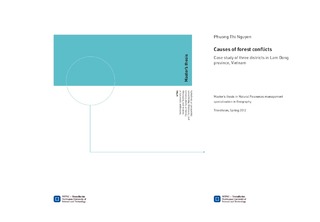| dc.contributor.author | Nguyen, Phuong Thi | nb_NO |
| dc.date.accessioned | 2014-12-19T14:26:16Z | |
| dc.date.available | 2014-12-19T14:26:16Z | |
| dc.date.created | 2013-04-24 | nb_NO |
| dc.date.issued | 2012 | nb_NO |
| dc.identifier | 617782 | nb_NO |
| dc.identifier.uri | http://hdl.handle.net/11250/265482 | |
| dc.description.abstract | It is said that examining the cause of natural conflict is not easy because conflict is not only complex issue but also involves in various factors and actors. Determining reason of contestation over natural resources brings significance not only for researcher but also for natural resource managers. Therefore, purpose of this study is to determine main causes of forest conflicts in three districts of Lam Dong province, Vietnam. By involvement of unequal distribution of benefit sharing derived from the forests among forest stakeholders and illegal forest actions, this research analyzes these factors in relation to causes of forest conflicts.
The qualitative method in geography is utilized in this study. The qualitative research data consisted of semi-structured interviews by interview guides and participant observation. For whole thirty interviewees, they come from three different levels; which are forest management agencies, including forest protection department, authorities (e.g. district and communal levels); forestry companies (e.g. state-own, joint venture, and private companies); and households.
From interview to review, most of respondents indicated that the main actors related to contradictions are local households and forestry companies. The conflicts between the two expressed in both peaceful and open forms. “Illegal” activities could result from directly conflict between local households and forest companies because these illegalities disrupt the revenue of the forestry companies. Due to imbalance of access rights for local households to forest resources, the conflict happened when forestry companies take more right of access rather than the local households. Unequal distribution of benefit sharing derived from the forest resources is another main cause of forest conflict between local households and forest enterprises. Conversely, the conflicts between households/forest enterprises and forest mangers seldom happen because of relative relationships and inconvenience.
This study is concluded that the contexts of forest conflicts in Lam Dong province are less common. Analyzing the impacts of forest conflict to livelihoods of forest-related people and seeking the resolution are recommended in further study. | nb_NO |
| dc.language | eng | nb_NO |
| dc.publisher | Norges teknisk-naturvitenskapelige universitet, Fakultet for samfunnsvitenskap og teknologiledelse, Geografisk institutt | nb_NO |
| dc.title | Causes of forest conflicts: Case study of three districts in Lam Dong province, Vietnam | nb_NO |
| dc.type | Master thesis | nb_NO |
| dc.contributor.department | Norges teknisk-naturvitenskapelige universitet, Fakultet for samfunnsvitenskap og teknologiledelse, Geografisk institutt | nb_NO |
